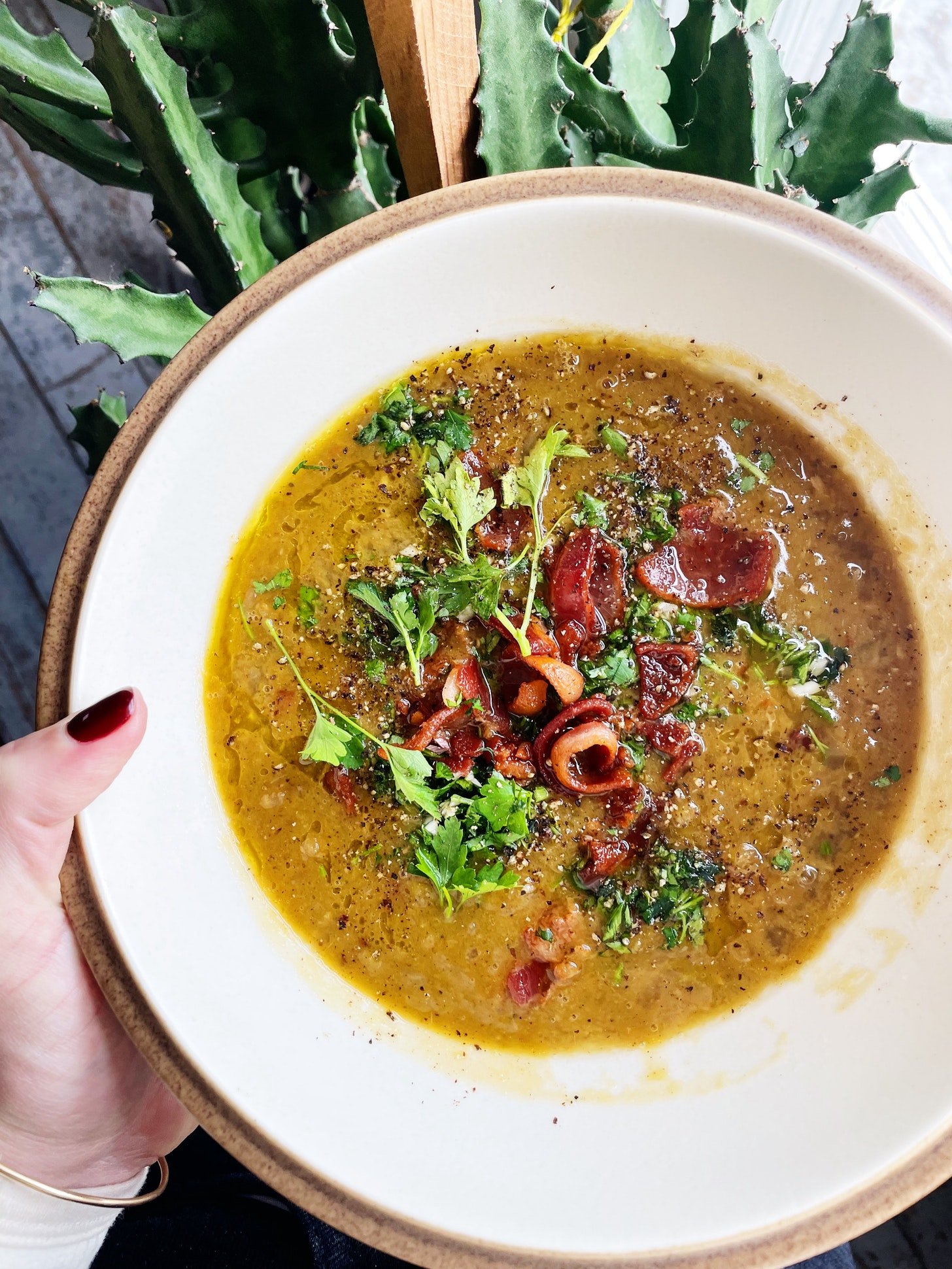Split Pea Soup
This is a simple recipe so I will just give you some simple tips: You don’t need a pressure cooker or a ham hock or a soak or hours of your day to make this. This will not be puréed or blended. You can make it with or without pork. A bay leaf really does add *a special something* here, but is optional. Of course I am advocating for the use of Better Than Bouillon, and no, this is not sponsored. Most importantly, perhaps: Rutabaga is a root vegetable, long ago made by crossing a cabbage and turnip. It’s less sweet than a parsnip or carrot and less starchy than a potato, but carries characteristics of both. Despite me never once seeing a recipe that calls for one, they are inexplicably in every grocery store in America, often covered in a waxy substance making them best peeled with a knife, not a peeler.
YIELD — 4 servings
Ingredients
8–10 ounces bacon, pancetta or guanciale*
1 yellow onion, 2 large shallots or 1 large leek, finely chopped
5 garlic cloves, 4 thinly sliced or finely chopped, 1 finely grated
Kosher salt, lots of freshly ground black pepper
1 rutabaga, large waxy potato, small sweet potato, or 2 carrots, peeled and finely chopped
1 cup split dried peas, yellow or green
8 cups vegetable broth, chicken broth or water plus Better Than Bouillon
Bay leaf or thyme, optional
½ cup parsley, finely chopped
Olive oil, to drizzle
Lemon, to squeeze
*To make this without bacon or any pork products, simply cook your onions/garlic in 2 tablespoons olive oil.
Directions
1. If using bacon, coarsely chop it into 1 ½”–2” pieces. If using pancetta, guanciale or some sort of fatty ham, cut into cute little ½” pieces. Place whatever pork product you’re using in a medium-large pot and cook over medium heat (not too hot, or else the fat won't properly render). Cook, stirring occasionally, until the meat is crisped and there is a generous pool of fat inside your pot, 6–10 minutes, depending on the size and fattiness of your pork.
2. Leaving all the fat behind, remove meaty bits with a spoon and set aside on a plate or small bowl. If you’re not using pork, do none of the above and instead drop 2 tablespoons or so of olive oil into your pot.
3. Add onions and sliced garlic to the fat and season with salt and pepper. Increase heat to medium–high and cook, stirring occasionally, until the onions are tender, translucent and lightly browned at the edges, 5–7 minutes.
4. Add rutabaga (or potato/carrots) and season with salt and pepper. Cook, stirring occasionally until they are totally tender and cooked through, at which point the onions will have a bit more color on them (a good thing), 8–10 minutes.
5. Add split peas, broth (or water + Better Than Bouillon) and either a bay leaf or a few sprigs of thyme, if you’ve got it. Yes, a bay leaf does do something to the broth! It is NOT a throwaway herb! I will die on this hill.
6. Bring to a strong simmer, then reduce to medium-low. Continue to gently simmer until the rutabaga and split peas are so cooked through and tender, they’re practically falling apart, 40–50 minutes. At this stage, I like to use a wooden spoon to gently smash some of the rutabaga and peas against the side of the pot, just to create a slightly thicker/creamier soup. But remember, this is a soup. It is not a stew. It is not a purée. It is a soup. Soup, by (my) definition is brothier, less homogenized and thinner than a stew. Split Pea Soup.
If at this stage you are finding it still too soupy, then feel free to keep simmering until your desired thickness is achieved.
7. Add the grated garlic, stir and season the soup with salt and pepper as needed. Ladle into bowls, top with the crispy pork, some of the parsley, a drizzle of olive oil, a squeeze of lemon.
DO AHEAD: This soup will keep in your fridge for at least 5 days, speaking from personal experience. It also freezes well (minus the toppings, of course).
EAT WITH: This soup wants a grilled cheese, or maybe extra toasted rye bread slathered with butter and a side of teenage vulnerability.
